Science
(www.olympiadsuccess.com)
Chapter 9: Soil
Class VII
Multiple Choice Questions
Question 1
The microorganisms present in the soil require moisture (water) and nutrients for growth and survival. Choose from the options below the habitat (place) where the soil has plenty of water and nutrients.
(a) Desert
(b) Forest
(c) Open field
(d) Cricket ground
Answer 1
(b)
Question 2
Availability of water and minerals in the soil for maximum absorption by roots is in the –
(a) B-horizon
(b) C-horizon
(c) A-horizon
(d) surface of soil
Answer 2
(c)
Question 3
Soil conservation measures are mainly aimed at protecting which of the following?
(a) Plants
(b) Top soil
(c) Sub soil
(d) Soil organisms
Answer 3
(b)
Question 4
Read the following statements with reference to soil.
(i) Weathering is a very fast process of soil formation.
(ii) Percolation of water is faster in sandy soils.
(iii) Loamy soil contains only sand and clay.
(iv) Top soil contains the maximum amount of humus.
Choose the correct statements from the above.
(a) (ii) and (iv) (b) (i) and (iii)
(c) (ii) and (iii) (d) (i) and (ii)
Answer 4
(a)
Very Short Answer Questions
Question 5
Soil has particles of different sizes. Arrange the words given below in increasing order of their particle size.
Rock, Clay, Sand, Gravel, Silt
Answer 5
Rock > Gravel > Sand > Silt > Clay
Question 6
The components of loamy soil are ______, ______ and ______.
Answer 6
sand, silt, clay
Question 7
Read the following statements and give the appropriate terms for each of them.
(a) The process of breakdown of rocks by the action of wind, water, sunlight.
(b) Removal of top soil during heavy rains or strong winds.
(c) Accumulation of wastes in the soil generated by human activity which alter the features of soil.
(d) The process of movement of water into deeper layers of soil.
Answer 7
(a) Weathering (b) Erosion (c) Soil pollution (d) Percolation
Question 8
Unscramble the following jumbled words related to soil.
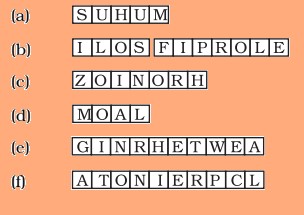
Answer 8
(a) Humus (b) Soil Profile (c) Horizon (d) Loam (e) Weathering (f) Percolation
Short Answer Questions
Question 9
Which of the following situations – ‘A’ or ‘B’ – is advantageous for absorption of water and minerals? Why?
Situation ‘A’ : Growth and branching of roots in the C-horizon.
Situation ‘B’ : Growth and branching of roots in A and B- horizons.
Answer 9
Situation ‘B’ is advantageous to plants because A- and B- horizons are rich in water, minerals and humus.
Question 10
How can a farmer convert acidic soil to neutral soil?
Answer 10
He can add a small quantity of quick lime or slaked lime solution to the soil. This will make the acidic soil neutral.
Question 11
Is it a good practice to remove grass and small plants that are growing in an open, unused field? Give reason to support your answer.
Answer 11
No, it is not a good practice. Plants cover the soil surface and their roots bind the soil particles and hold them in place. During strong winds and rains they prevent soil erosion and thereby protect the top soil.
Question 12
A man digging a pit found that he could dig with ease initially but digging became difficult as he went deeper. He could not dig beyond a depth of 5 feet. Provide a suitable scientific explanation.
Answer 12
The soil surface has loose top soil which is easier to dig. At
deeper layers, partially weathered rocks or bedrocks are present,
which are hard making digging difficult.
Question 13
Locate the following zones given as boxed items in Figure 9.1 which shows a diagram of soil profile.
Top soil, Subsoil, C-horizon, Bedrock
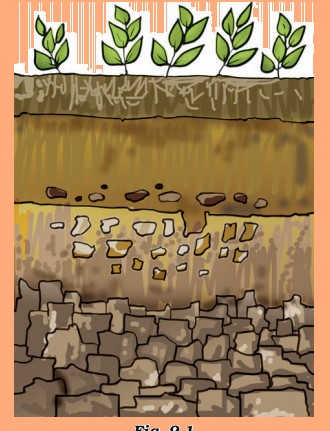
Answer 13
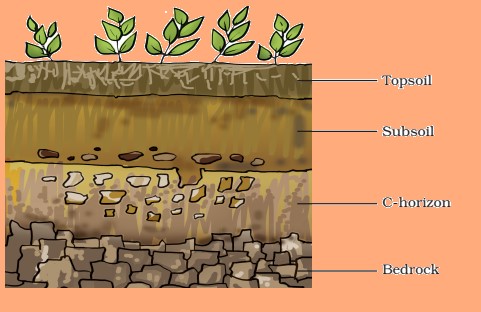
Question 14
Rajasthan is a desert state in India. Once while travelling to Rajasthan by train, Boojho observed several streams and rivulets of rain water during the journey but to his surprise he did not see streams of water in the desert region even during rains. Help Boojho find a suitable explanation for this.
Answer 14
Deserts are vast stretches of sand where the falling rain water immediately percolates downwards in the spaces between sand particles. Due to this he did not see streams of water in the desert region.
Question 15
Match the animals in Column I with their natural place of dwelling (habitat) in Column II.
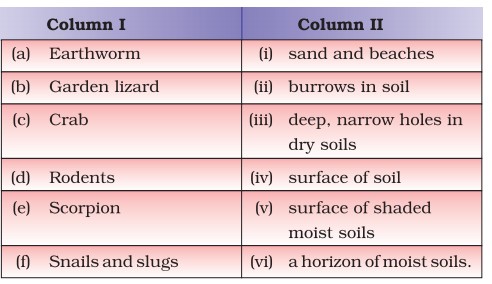
Answer 15
(a) (vi); (b) (iv); (c) (i); (d) (ii); (e) (iii); (f) (v)
Long Answer Questions
Question 16
Continuously water-logged soils are disadvantageous for plant growth. Why?
Answer 16
Roots, although underground, possess living cells that require oxygen for respiration and production of energy. They absorb oxygen that is present in the spaces between soil particles. But in water-logged soils, water occupies the spaces between soil particles and pushes the oxygen out into the atmosphere. Thus, roots are deprived of oxygen and this affects root and plant growth.
Question 17
Why is soil erosion relatively less in dense forests as compared to barren, open fields?
Answer 17
In dense forests, the tree cover (canopy) prevents rain water from directly falling on the ground/soil. Also roots of the vegetation bind the soil particles and hold them together. As a result soil erosion is minimised.But in barren, open fields the soil is exposed to the falling rain. The soil particles become loose due to the impact of raindrops and the flow of water carries them away. The flowing water further erodes the soil surface aggravating erosion.
Question 18
Gardeners gently dig up the soil around the roots of garden herbs (plants) frequently. Give reasons.
Answer 18
(a) For enabling easy root growth;
(b) For easier percolation of water;
(c) For aerating the soil/enabling air to get into deeper layers of soil;
(d) For removing the weeds.
Question 19
In towns and cities, generally, the bore wells have to be dug very deep to get water as compared to bore wells dug in villages. Give suitable reasons.
Answer 19
(a) This is so because of excessive use of water which depletes the ground water.
(b) Towns and cities have asphalted roads and vast areas of soil are concreted. As a result, rain water cannot percolate to recharge ground water and the ground water level further decrease. Villages have larger areas of open soil surface and fewer asphalted roads and concrete surfaces. Thus, larger soil surface area is available for rain water to percolate into the soil easily and recharge the ground water. As a result, even shallow borewells yield water.
Question 20
Several terms related to soil are hidden in the squares given as Figure 9.2. Spot them and make a list.Two examples are given for you.
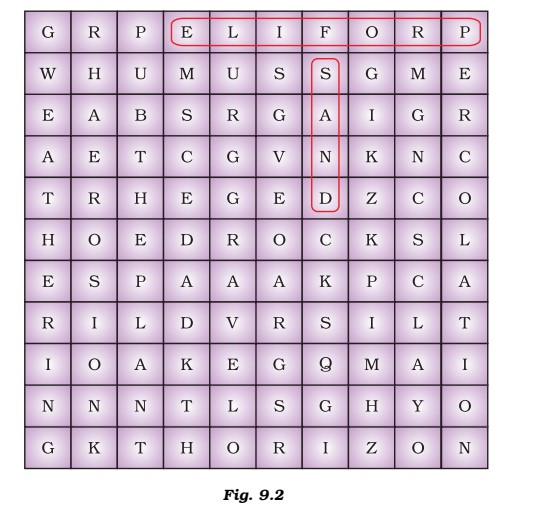
Answer 20
Humus, Sand, Water, Clay, Gravel, Weathering, Horizon, Percolation, Mineral, Plant, Erosion, Profile.
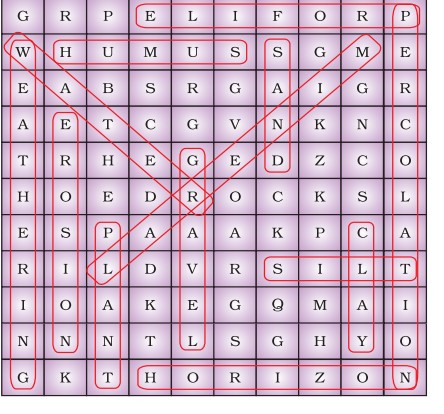
Yearlong program for Olympiads preparation & to build necessary skills for future.
Explore More
Time to mark your calendar with the upcoming Olympiads exam schedule.
Explore More
Take your Olympiad preparation to next-level by taking LIVE Classes.
Explore More
Assess your performance by taking topic-wise and full length mock tests.
Explore More
Online tuitions for international compeitions like SASMO, SEAMO, etc for Grades 1-11.
Explore More